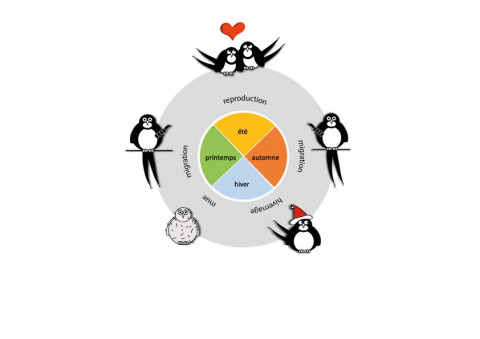Surviving winter
In our regions, food resources can be very scarce during the bad season, especially for insectivores. Some birds then move to places where they will find an abundance of food: they are migratory. The others, which remain on the spot, are called sedentary and must face the rigorous cold of winter. Fortunately, their bodies and behavior are adapted to survive until the following spring.
Sedentary birds
Sedentary birds adapt their diet to what they can find. The Blue Tit and the Chattering Magpie, for example, feed on seeds when insects are scarce. Others rely on provisions they have hidden in the fall, such as the Oak Jay, which buries acorns.
They also have different strategies for fighting the cold :
- In winter birds have more feathers that appear inflated, this cushion of air insulates the animal from the cold (e.g., the Tree Finch).
-
To sleep, they may gather together to keep warm. For example, chickadees find a hole for the night and gather there. Starlings, for their part, gather at the end of the day in cities or villages because it is warmer there than in the countryside and form collective dormitories in the trees.
-
Some birds, such as the tree chaffinch, also see their temperature drop by 6°C during their sleep to consume less energy, like hibernating animals.
-
Finally, there are false sedentary birds such as the Common Nighthawk or the Robin. They can be seen all year round in gardens but often they are not the same individuals. Part of the populations of our regions migrate towards the South, and are replaced by individuals coming from the North of Europe to spend the winter here.
Sedentary lifestyles are not so common:
In fact, very few species in Europe are strictly sedentary, i.e. with no population or part of its population migrating. They may move, at least for a short distance, often for exceptional reasons such as a cold snap.
In cities, some species are more likely to settle down because there is a permanent food supply. However, House Sparrows and Wood Pigeons can be found on migration sites in autumn.
Migratory birds
In birds, migration is the regular movement of populations from a breeding area to a wintering area in the fall and back again in the spring. They do not remain on their wintering grounds to breed but return to temperate regions because competition for food and the presence of predators are less important there.
The fall phase is also called post-nuptial and the spring phase is the pre-nuptial phase.
Several species of parks and gardens, but also of cities and villages, are absent from our country between October and March-April, such as the Gray Flycatcher, the White-fronted Redstart, the Barn Swallow, the Window Swallow or the Black Swift.
Long-haul migrants
Insectivores are highly migratory (in winter, there are few insects in our regions), while granivores or omnivores are rather sedentary or migratory over small distances.
The barn swallow is an example of a bird making long migrations: it travels to the South of the Sahara to find its food and returns to the temperate region in spring to breed. We can then find it in Eurasia and North America but also in North Africa.
Medium-haul migrants
Their journeys are less long than the previous ones because their wintering area is less distant. They are generally insectivores and also feed on seeds, like the Tree Chaffinch, the Music Thrush and the Robin. The whole species goes down a little further south, in the Mediterranean basin. They generally leave later than the large migrants and return earlier.
All about migration
Most long-distance passerines fly at night (except swallows). Those that migrate during the day only move in the morning and feed during the rest of the day, this is especially the case for short-distance migrators that have more time.
What are the advantages of night migration?
It allows to move at night and to feed during the day. Moreover, the flight is easier because the horizontal winds are less violent and vertical turbulences are rarer. The air is also cooler and more humid, so energy expenditure is reduced and the risk of dehydration is lower.
How do birds know when to leave?
In nocturnal migrants, it is the change in daylight hours (photoperiod) that triggers the preparation for migration; birds perceive light through photoreceptors located in their brain and sensitive through the feathers and skull, so even blind birds perceive it.
How do birds prepare for migration?
Some birds molt to get brand new feathers that are perfectly efficient for the long flight ahead.
Birds also build up energy reserves. These are accumulated as fat stored under the skin, in the muscles and in the liver. At the same time, the size of their digestive tract decreases to prevent them from being too heavy.
What are the dangers?
Predators such as hawks and falcons are the most important danger, for example they have been estimated to kill 10% of Tree Finches and Northern Finches. High winds can displace birds. It is estimated that 1 to 10% of small passerines migrating along the coast die at sea. Humans are also a danger to migratory birds. 15 to 20 million migratory birds are killed each year by hunters who hunt at sites where the birds stop to feed. Development also destroys staging areas, and the installation of power lines or tall buildings with large windows is a danger to these migrants.
How do they find their way around?
The phenomenon is complex and not yet fully understood. Birds seem to move according to a knowledge that they inherit from generation to generation and that dictates both the time of migration but also its direction and destination. However, it is known that birds diverted from their usual routes, for example by strong winds, are able to find the right course.
They are guided by a system of internal compasses also called biological compasses which would be of 3 types :
- The solar compass used for small or large migrations,
- The stellar compass for which the young bird should learn the sky map,
- The magnetic compass: this compass seems to be the most used especially in cloudy weather (the earth has two magnetic poles located near the geographical poles).
Sight also allows them to orient themselves thanks to the ability to determine where the light comes from (polarized vision). They also use visual landmarks such as mountain ranges, rivers, etc.




